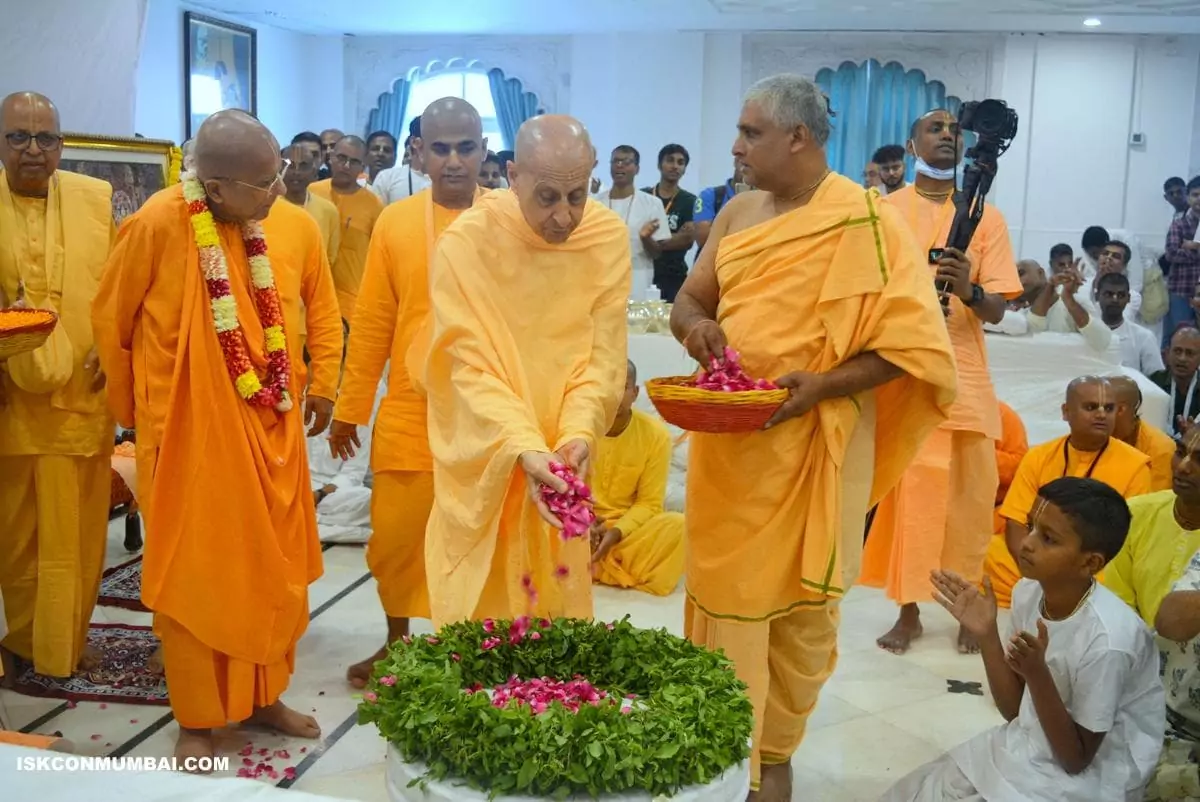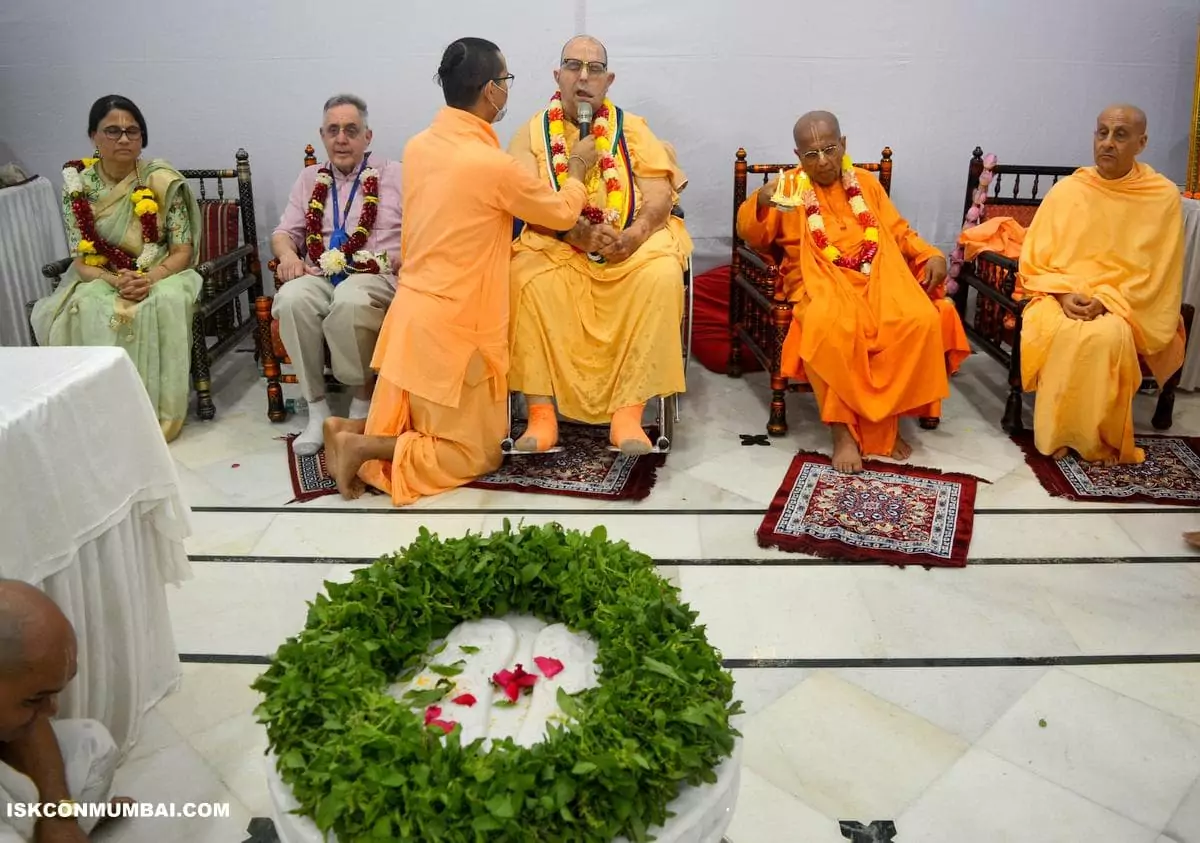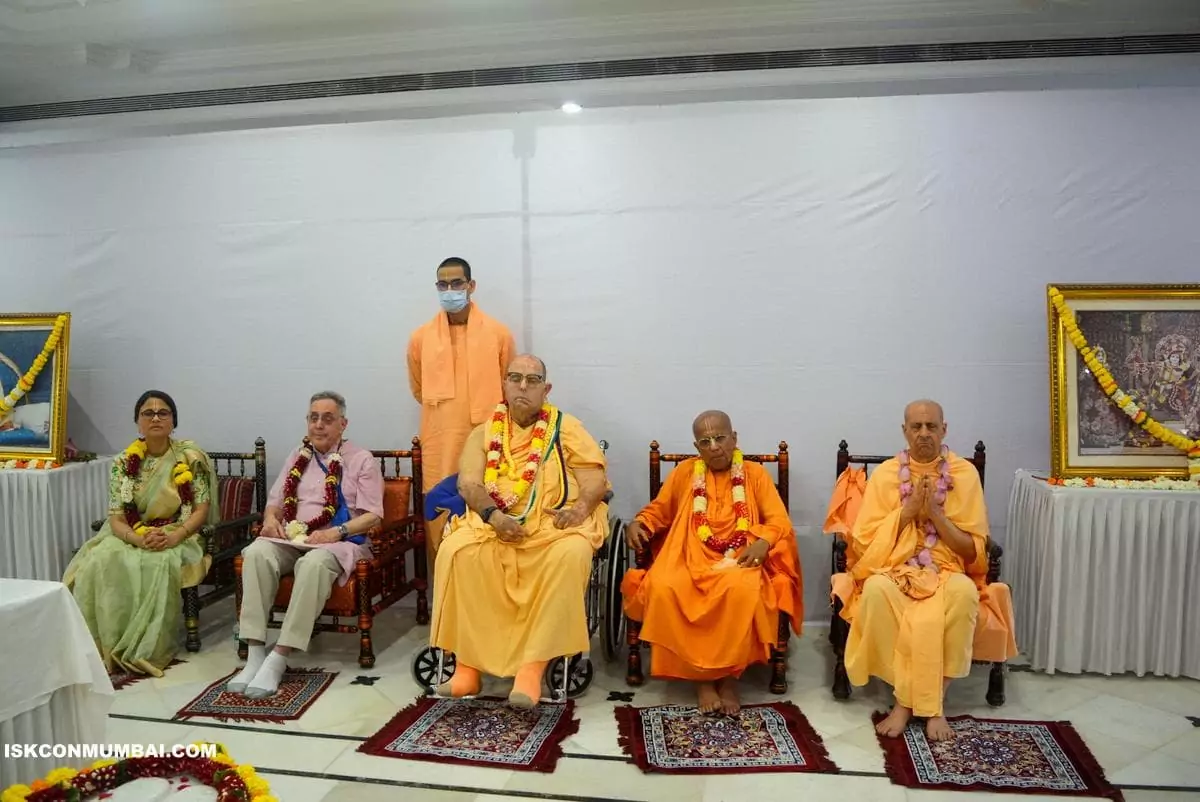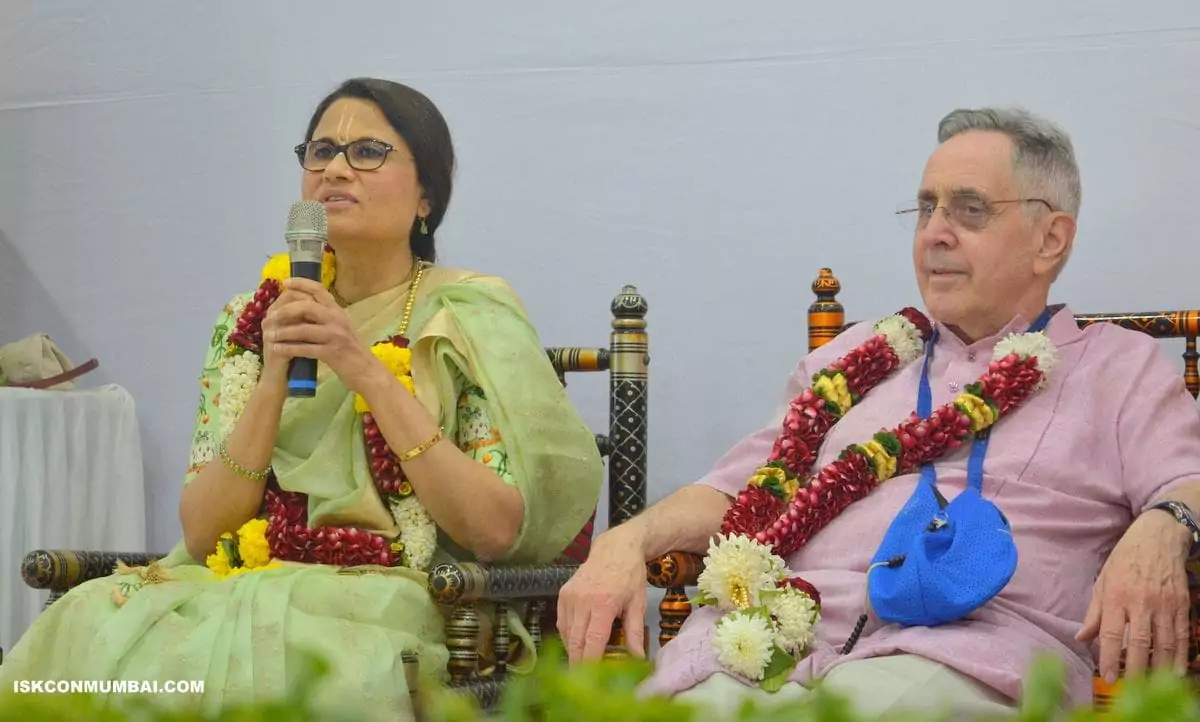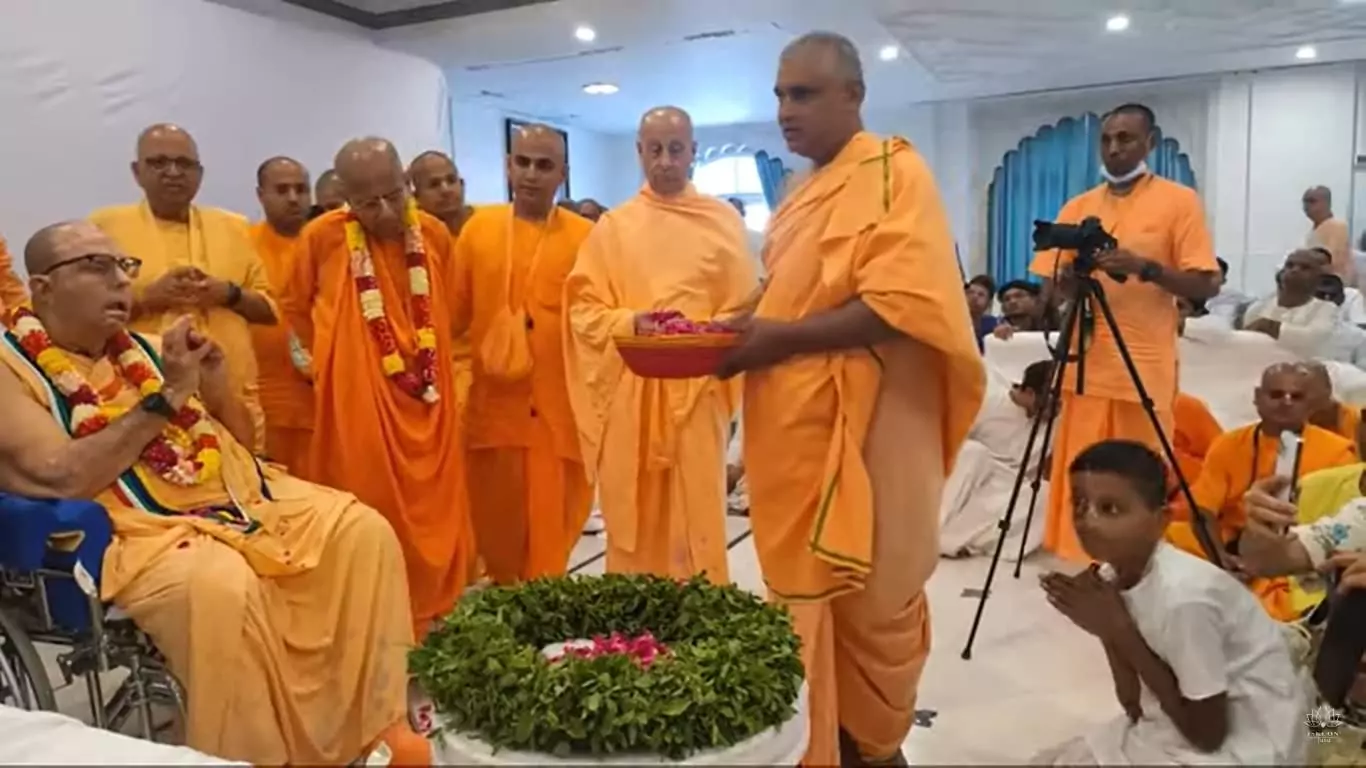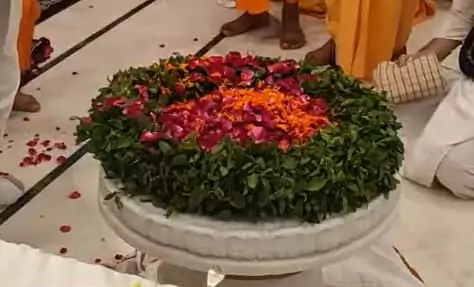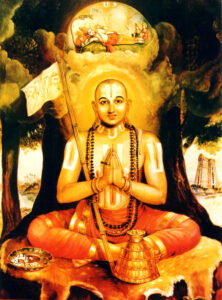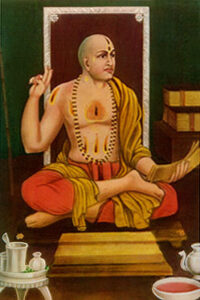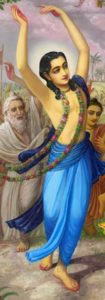 We welcome you on this most auspicious occasion of the appearance day of Sri Nityananda Prabhu. According to the Bhagavad-gita, Srimad-Bhagavatam, and Sri Caitanya-caritamrta, the Absolute Truth is realized in three features. Preliminary is Brahman, the impersonal light that emanates from the transcendental form of the Lord. Next is Paramatma, the localized Supersoul within the hearts of all living entities. And the last word in realization of the Absolute is Bhagavan, the Supreme Personality of Godhead, Krishna. The jnanis who realize the impersonal Brahman experience only the sat, eternal, aspect of the Absolute Truth. The yogis who realize the Paramatma within the heart experience the eternal, sat, and cognizant, cit, features of the Absolute Truth. Only the devotees, who realize Krishna, experience ananda, bliss, which is the goal and ultimate nature of every living entity.
We welcome you on this most auspicious occasion of the appearance day of Sri Nityananda Prabhu. According to the Bhagavad-gita, Srimad-Bhagavatam, and Sri Caitanya-caritamrta, the Absolute Truth is realized in three features. Preliminary is Brahman, the impersonal light that emanates from the transcendental form of the Lord. Next is Paramatma, the localized Supersoul within the hearts of all living entities. And the last word in realization of the Absolute is Bhagavan, the Supreme Personality of Godhead, Krishna. The jnanis who realize the impersonal Brahman experience only the sat, eternal, aspect of the Absolute Truth. The yogis who realize the Paramatma within the heart experience the eternal, sat, and cognizant, cit, features of the Absolute Truth. Only the devotees, who realize Krishna, experience ananda, bliss, which is the goal and ultimate nature of every living entity.
When an interviewer once asked Srila Prabhupada, “What is the goal of life?” Srila Prabhupada replied, “The goal of life is to enjoy.” Now, the effort to enjoy materially, through the mind and senses, leads only to frustration and misery, but spiritually one can enjoy in relation to the Supreme Personality of Godhead, and that pleasure, unlike the temporary so-called happiness of the material world, is eternal, and that eternal happiness can be realized through the mercy of Sri Nityananda Prabhu. Nitya means “eternal” and ananda means “bliss.” So, if we can come in touch with Lord Nityananda, we can realize that eternal bliss for which we are hankering.
How do we become eligible for Lord Nityananda’s mercy? That we can learn from the description of His qualities and pastimes in Sri Caitanya-caritamrta, the most authorized book, biography, about the teachings and activities of Lord Chaitanya and Lord Nityananda and Their associates. There are a number of verses that summarize the pastimes of Lord Chaitanya and Lord Nityananda, but one is especially instructive, from Adi-lila, Chapter Seventeen: “The Pastimes of Lord Caitanya in His Youth”:
TEXT 17
tabe saci dekhila, rama-krsna—dui bhai
tabe nistarila prabhu jagai-madhai
TRANSLATION
Thereafter Mother Sacidevi saw the brothers Krsna and Balarama in Their manifestation of Lord Caitanya and Nityananda. Then the Lord delivered the two brothers Jagai and Madhai.
PURPORT by Srila Prabhupada
One night Sacidevi dreamt that the Deities in her house, Krsna and Balarama, had taken the forms of Caitanya and Nityananda and were fighting one another, as children do, to eat the naivedya, or offering to the Deities. On the next day, by the will of Lord Caitanya, Sacidevi invited Nityananda to take prasada at her house. Thus Visvambhara (Lord Caitanya) and Nityananda were eating together, and Sacidevi realized that They were none other than Krsna and Balarama. Seeing this, she fainted.
COMMENT by Giriraj Swami
The story is that Sacidevi had a dream and told her son Nimai, “Last night I had a wonderful dream, and in this dream You and Nityananda went into my Deity room, and You picked up the Deity of Balarama, and Nitai picked up the Deity of Krishna, and the Deities started to protest, ‘You can’t take Us from the altar. You can’t take Us out of the Deity room.’ And You and Nityananda replied, ‘Your days of stealing butter and playing pranks are over. Now You are appearing as brahmans to chant the holy names.’ ” Then They started to fight over Mother Saci’s offerings, and Krishna and Balarama said, “These are meant for Us. You can’t have these.” And Gaura and Nitai were saying, “But now You have appeared as Us, so We can take them.”
Mother Saci asked Lord Chaitanya, “What do You think of this dream?” and Lord Chaitanya said, “This is a very wonderful dream, but don’t tell anyone about it.” Because He was concealing His identity as the Supreme Personality of Godhead, He didn’t want anyone to know that He was Krishna and Nityananda was Balarama.
Then Lord Chaitanya said, “I would go into the Deity room to have maha-prasada and see that half of it was gone.” His wife, Vishnu-priya, was listening to this, and He knew that she was listening, so He said, “When I would see that half of the offering was gone, I would suspect that it was Vishnu-priya who took the maha-prasada, but now I am seeing that these Deities are very mystical, and I am suspecting that They Themselves might be eating half of the remnants meant for Us.” He continued, “Anyway, I think tomorrow you should invite Nityananda for lunch.” So, she did, and as They were having lunch, she saw Them transform Themselves into Krishna and Balarama, and she fainted.
PURPORT (continued)
Jagai and Madhai were two brothers born in Navadvipa in a respectable brahmana family who later became addicted to all kinds of sinful activities. By the order of Lord Caitanya, both Nityananda Prabhu and Haridasa Thakura used to preach the cult of Krsna consciousness door to door. In the course of such preaching they found Jagai and Madhai, two maddened drunken brothers, who, upon seeing them, began to chase them. The next day, Madhai struck Nityananda Prabhu on the head with a piece of earthen pot, thus drawing blood. When Sri Caitanya Mahaprabhu heard of this, He immediately came to the spot, ready to punish both brothers, but when the all-merciful Lord Gauranga saw Jagai’s repentant behavior, He immediately embraced him. By seeing the Supreme Personality of Godhead face to face and embracing Him, both the sinful brothers were at once cleansed. Thus they received initiation into the chanting of the Hare Krsna maha-mantra from the Lord and were delivered.
COMMENT
This is a very important pastime of Lord Chaitanya and Lord Nityananda, and it is worth considering in detail, because it will give us an insight into the actual mission of Gaura-Nitai and, through parampara, disciplic succession, the mission of Srila Prabhupada and consequently the mission of his followers.
So, Chaitanya Mahaprabhu ordered Nityananda Prabhu and Haridasa Thakura to go into Navadvipa to approach whomever they met on the way and to go door-to-door and approach people at home and request them to chant the name of Krishna, to worship Krishna, to accept Krishna as their life and soul and the treasure of their wealth—and not to distinguish between who was qualified and who was not. Many people in Navadvipa were pious, and when Nityananda Prabhu and Haridasa Thakura approached them, they accepted the request. And they all developed pure love for Krishna.
One day, as Nityananda and Haridasa Thakura were making their way around Navadvipa, they saw a large crowd of people watching a spectacle from a distance. When they approached, they saw two drunken brothers, Jagai and Madhai. “They were born in a respectable brahman family,” the townspeople explained, “but in their youth they fell into bad association and have engaged in all sorts of sinful, horrible activities. They drink wine, they murder people, they burn down their houses, they loot and rob and plunder them. They rape women. They eat cows’ flesh. There’s not a sin they have not committed. They are extremely dangerous, and the whole of Navadvipa lives in fear of them.”
Nityananda Prabhu thought, “So far, we have been approaching pious folks and they’ve taken up the order of Mahaprabhu and become pure lovers of Krishna, but no one really knows the glories of Chaitanya Mahaprabhu’s mercy. If we can convert Jagai and Madhai, then everyone will know the magnitude of Mahaprabhu’s mercy.” So, Nityananda, accompanied by Haridasa, approached the drunken brothers and delivered the message: “Chant Krishna’s name, worship Krishna, follow Krishna’s instructions, glorify Krishna, and give up your sinful activities.” The two were physically powerful, though—very powerful and very arrogant—and they became enraged: “Who are these people to tell us to worship Krishna and give up our activities?” They decided to kill Haridasa and Nityananda and started to pursue them, shouting, “Kill them! Kill them! Kill them!” They were running after them, and Nityananda Prabhu and Haridasa Thakura were running for their lives.
While they were fleeing, Nityananda Prabhu said, “Haridasa, I think this is the end of both of us. This is it.” And Haridasa replied, “I think You are right.” Then Nityananda said, “But you were caned in twenty-two marketplaces and Krishna saved you, so why don’t you pray to Krishna to save us now?” And Haridasa said, “Yes, that’s true, but at that time I wasn’t associating with a madman like You. You went up to the two biggest demons on the planet and told them to chant Hare Krishna and give up their sinful activities! All the townspeople told us, ‘Stay away from them; they are very dangerous,’ but You didn’t listen.” Nityananda defended Himself: “You are blaming Me, but actually I’m not the one to blame. It’s your master, Gauranga Mahaprabhu, who’s responsible. Never in the history of the world has a brahman acted like Him, like a king ordering people to go out in the town and approach people whether they are pious or sinful and ask them to chant Hare Krishna. I was just following His order. So don’t blame Me; blame Him.” And He added, “If we don’t obey His order, we’re finished, and if we do obey His order, we’re finished.” Like that, they were joking and laughing as they were fleeing for their lives, Jagai and Madhai in hot pursuit.
Eventually Jagai and Madhai, though strong and powerful and angry, couldn’t keep up. They were a little heavy and quite drunk, so eventually they fell behind, and Nityananda and Haridasa Thakura ran to Mahaprabhu. The Lord had asked them to come report to Him every evening after their preaching, and they told Him what had happened. When He asked, “Who are these Jagai and Madhai?” Gangadasa Pandita and Srivasa Thakura explained, “They are most sinful. The whole of Navadvipa lives in terror because of them. They kill people, they rape women, they burn down people’s houses, they plunder their riches, they drink strong liquor, and they eat cows’ flesh.” Mahaprabhu said, “I will kill them. I will cut them to pieces.” But Nityananda Prabhu—and this is His extreme mercy—said, “No, Lord, don’t do that. Don’t harm them. In Kali-yuga our mission is not to kill the demons but to deliver them. And in Kali-yuga pretty much everyone will be like Jagai and Madhai. So don’t kill them. You give them to Me; I will take charge of them.” Gauranga Mahaprabhu agreed, “All right, I put them in Your charge, and because You want to give them mercy, I predict that very soon they will be delivered.”
While Chaitanya Mahaprabhu was speaking with Nityananda, Haridasa Thakura, who was sitting with Advaita Acharya, said, “You do not know how difficult it is to have a sankirtana partner who is a madman. He is an avadhuta. He goes to people’s houses and steals their butter and yogurt.” If the householder came out and pursued them, Nityananda Prabhu, who was younger, would be gone, and they would catch Haridasa. Sometimes Nityananda would ride on people’s bulls and say, “I am Mahesh!” And sometimes He would milk the cows and drink all the milk. Sometimes He would approach small boys and say, “I’m going to beat you!” and they would become frightened and run home to their parents, and their fathers would come out with sticks to protect their child. And Nityananda would escape, but they’d catch Haridasa, and he would fall at their feet and plead, “Please, please, it’s not what you think.” And sometimes Nityananda would go up to innocent young girls and say, “I want to marry you.” “But the worst was today,” Haridasa said. “Everyone told us to stay away from these drunken demons, and He went right up to them and said, ‘Give up your sinful activities, surrender to Krishna, and chant Krishna’s name.’ They almost killed us! We barely escaped with our lives.”
Advaita Acharya began to laugh in ecstasy but with a little anger and said, “Why are you surprised? It is the nature of drunkards to associate with other drunkards. Nityananda Prabhu is always intoxicated with krsna-prema, prema-rasa, so it’s natural for Him to want to associate with other drunkards. But you are a naistika-brahmachari, sober and learned, so why are you associating with those three? You let them associate with one another. Why should you get involved with them?” Then He said, “I know the power of My Nityananda, and you will see within one or two days that these rogues will be chanting and dancing in kirtan with us.”
A day or two later, as Nityananda Prabhu was wandering around Navadvipa in His playful mood, He again came upon the two drunk brothers. And again He approached them and delivered the same message, and again Madhai was enraged: “Who is this person? We almost killed him the other day, and still he is coming back. Who does he think he is?” Then he asked, “Who are you? What is your name?” Nitai replied, “I am avadhuta.” And that was it. Madhai picked up a clay pot, and with all of his immense strength he smashed the head of Nityananda Prabhu and cut a big gash. Blood covered Nitai’s face and gradually His whole body. “I don’t mind that you struck Me,” He told Madhai, “but what really pains Me is how much you are suffering in ignorance. Please accept the mercy of Gauranga Mahaprabhu and you’ll be happy.”
That infuriated Madhai even more, so he picked up another pot, wanting to kill Nitai—he was ready to smash Him—but Jagai intervened and said, “Stop it! Can’t you see that this is a genuine saintly person, that he actually has love for you and feels compassion for you? He is trying to help you. What will you gain by killing such an innocent soul?”
Meanwhile, the news of Madhai’s attack reached Chaitanya Mahaprabhu, and He rushed to the scene—as Prabhupada said, angry as fire—and immediately called for His Sudarshan chakra to kill them. The chakra came like the blazing sun, but Nityananda Prabhu intervened. “Lord, don’t kill them,” He beseeched Mahaprabhu. “I am going to,” Lord Chaitanya replied. “They have harmed My Nitai, and I am going to kill them.” Still, Nityananda said, “But Jagai saved Me. Madhai was wanting to kill Me, but Jagai stopped him; he saved My life.”
When Mahaprabhu heard that, His heart melted and the chakra immediately disappeared. He embraced Jagai and said, “You have saved My Nitai. You have saved My Nitai. I forgive you for all that you have done.” After embracing him, He manifested a four-armed form with the symbols of Vishnu—the club, disc, lotus, and conch—placed His lotus foot on the heart of Jagai, and filled him with ecstatic love for Krishna. And Jagai was weeping in ecstasy.
Then Chaitanya Mahaprabhu turned His attention back to Madhai. He was still angry and ready to kill him, but Madhai’s heart had also changed. The Caitanya-bhagavata describes that the two of them, Jagai and Madhai, were so close they were like one soul in two bodies. So, by Jagai’s heart changing, Madhai’s heart also changed. And, of course, he didn’t want to be killed. He said, “You have given mercy to Jagai, but we’re together; we’ve done everything together. Whenever we plundered someone’s house, we did it together. Whenever I burned down someone’s house, he was with me. Whenever I drank liquor, he was with me. Whenever I ate cows’ flesh, he was with me. We did everything together, so why are You giving him mercy and not me? You should give me mercy, too.” Mahaprabhu replied, “No, I will not give you mercy, because you have hurt My Nitai.” Madhai said, “We’ve read in scriptures that so many demons attacked You with weapons and You delivered them all. So You should deliver me too.” And Mahaprabhu replied, “No, I will not deliver you. Nityananda’s body is more dear to Me than My own. Those demons attacked My body and I delivered them, but you attacked Nitai’s body, which is more dear to Me. I will not forgive you.”
Chaitanya Mahaprabhu was poised to kill Madhai, and Madhai pleaded for mercy. Then Mahaprabhu showed the way: “You beg for Nitai’s mercy. If He gives you mercy, then I will spare you.” So Madhai prayed to Nityananda Prabhu, and Mahaprabhu told Nitai, “If You actually forgive him, then You should embrace him.” And Nityananda, His whole body still covered with blood, picked up Madhai, who had prostrated himself, and embraced him. That is how merciful He is. Then Chaitanya Mahaprabhu said, “All right, I will spare you.” Nitai said, “Now I give him to You.” Then Chaitanya Mahaprabhu gave Madhai prema-bhakti. This is inconceivable—He gave him something that Lord Brahma doesn’t have. He gave him something that great rishis and sages and devas are endeavoring to get. He gave it to Madhai and Jagai, and they were the most horrible, sinful reprobates.
So, all that Nitai wanted came true. Later, back at Mahaprabhu’s house, the devotees had sankirtana, and Mahaprabhu said that all of Nitai’s desires would come true. Nitai was thinking, “If these two demons, the worst on the planet, could receive Chaitanya Mahaprabhu’s mercy, then My traveling everywhere and preaching will be successful.” He thought, “If I can convert these two demons to accept the mercy of Chaitanya Mahaprabhu, then I can actually consider Myself a servant of Chaitanya Mahaprabhu. And if these two demons can chant and dance in ecstasy with the Vaishnavas, I can consider that My name, Nityananda, has value and is true.”
There was a big festival of kirtan, and Chaitanya Mahaprabhu said, “Don’t any of you think that Jagai and Madhai are sinful. I will accept all their sinful reactions. Just watch.” And as Gauranga, in His beautiful golden form, began to accept their sinful reactions, His body turned black. “What do You see? What do I look like?” He asked Advaita Acharya. “I see Syamasundara,” Advaita replied. “Gaurasundara has become Syamasundara.” Then Chaitanya Mahaprabhu asked, “Now how will I get free from these sinful reactions? It will be through hari-nama-sankirtana. So, all of you do hari-nama-sankirtana, and I will be relieved of these sinful reactions. But then where will the sinful reactions go? Into the hearts of those who blaspheme Vaishnavas, who criticize devotees.”
So, they had ecstatic kirtan, and Mahaprabhu with His black form was dancing in ecstasy, and gradually the black went away; His form became lighter, and He resumed His original beautiful fair Gauranga golden hue.
After this, the Vaishnavas accepted Jagai and Madhai, but especially Madhai felt guilty, because he had tried to kill Nityananda Prabhu, who was the cause of his deliverance. He was very sad. Nityananda Prabhu could see this and inquired, “You’ve been liberated, you’ve been given prema-bhakti—why are you so sad? Don’t be sad.” Madhai replied, “When I think that I tried to kill You, I feel terrible. I just can’t forgive myself.” Nityananda told him, “I accept you like My son. Sometimes a child will hit the parent, but the parent doesn’t take it seriously. I forgive you.” Madhai said, “But what about all the other people I wronged and caused pain to? I was so intoxicated, I don’t even know who they are. I don’t even know how to ask them to forgive me. I hurt so many.” And Nityananda Prabhu said, “You should make a ghat—a very beautiful ghat—with your own hand, and when people come to take bath, you prostrate yourself before them and ask them to forgive you. And serve whoever comes, in any menial way. Being close to the Ganga, you will be purified.”
So, Madhai did that, and when people saw how humble he and his brother had become, their hearts melted and they gave them all affection and respect. But there were some people who were still angry, who had been so hurt by the brothers, by Madhai in particular, and seeing him in that humble position, they would take up a stone and throw it at his head. Madhai was now so meek, however, that he would pick up the stone and return it to them, saying, “I am so sinful. I’ve caused so much pain to others. Once is not enough; you should hit me again.” Even the people who were the most upset and angry had to forgive him and embrace him.
This is the mercy of Gaura-Nitai, and that was what Nityananda Prabhu wanted: that people should understand the glory of Mahaprabhu’s mercy. Srila Prabhupada took up the same mood of approaching anyone and everyone—pious or sinful, qualified or unqualified—without discrimination. As Nityananda Prabhu said, in Kali-yuga practically everyone will be like Jagai and Madhai. That may be more apparent in America and Europe than in India—though I did hear a talk in which Srila Prabhupada was discussing how demonic Western civilization is and how the leaders, and pretty much everyone, are demons, but then added, “Actually in my country also, 80 percent are demons.” But still, what Prabhupada encountered in 1965 when he came to America was something that people now, especially people in India, can’t even imagine.
Krsna Candra Prabhu (Hrishikesh Mafatlal), from Mumbai, used to say that people cannot imagine who Srila Prabhupada faced when he went to America. He recommended that everyone see the DVDs of Srila Prabhupada when he came to America, first at 26 Second Avenue in New York, then at Golden Gate Park in San Francisco. You just can’t believe, can’t imagine, the type of people he was approaching. And they didn’t always receive him well.
There was one incident when Srila Prabhupada was in New York—I hope you’ve read Srila Prabhupada-lilamrta; everyone should read the Lilamrta, as well as see the series Following Srila Prabhupada—living in a loft in the Bowery, which was the most degraded part of the city, its “Skid Row,” inhabited mostly by drunks. But even they had a little respect. They would be sprawled out on the sidewalk and on the stairs leading up to Prabhupada’s apartment, but somehow they sensed that Prabhupada was a saintly person, and they would try to move over and make room for him to pass.
Prabhupada was staying with a young man who seemed interested in Krishna consciousness. In fact, Prabhupada thought, “I’ll train him as a Vaishnava.” But one day the young man went crazy, probably from taking LSD or something—the 1960s equivalent of the strong wine that Jagai and Madhai were taking five hundred years ago. He went crazy and wanted to attack Srila Prabhupada. And he was ready to kill him, like Madhai was ready to kill Nityananda Prabhu. Srila Prabhupada bolted out of the room and ran down the stairs, with this young man in pursuit—very similar.
It is quite a history, how Srila Prabhupada stayed in different people’s places, and what he endured for the sake of delivering the mercy of Gaura-Nitai is inconceivable. On the boat to America he had suffered two heart attacks, and even in America he had a lot of physical problems. But he endured everything—all these attacks of maya—for the sake of delivering Gaura-Nitai’s mercy to us. And what Nityananda Prabhu wanted in India has been fulfilled by Srila Prabhupada outside India. What Nityananda Prabhu wanted was fulfilled in Bengal, but through Srila Prabhupada it’s been fulfilled throughout the world. So, Srila Prabhupada is really the embodiment of that mercy of Nityananda Prabhu. There’s no one in the history of our sampradaya, no one after Nityananda Prabhu, who has taken up that mood of approaching anyone and everyone without discrimination, without considering who is qualified and who is not.
And it’s the same message: chant Krishna’s name, worship Krishna, follow Krishna’s instructions (bolo krsna, bhaja krsna, koro krsna-siksa)—but not in so many words, because the people that Srila Prabhupada was approaching didn’t even know who Krishna was. When Nityananda approached people in Navadvipa, “Chant Krishna’s name, worship Krishna, accept Krishna as your life and soul,” they knew who Krishna was, they knew what He was saying, but in America and Europe nobody knew who Krishna was. So even “Chant Krishna’s name, worship Krishna” had to be explained in detail in books, and thus Srila Prabhupada wrote so many books to explain who is Krishna, what is Krishna’s name, how to chant Krishna’s name, how to worship Krishna, why we should accept Krishna as our life and soul, why we should surrender to Krishna—the same message that Chaitanya Mahaprabhu asked Nityananda Prabhu to deliver to everyone, but in an expanded form, because the people Prabhupada was approaching had no idea of Krishna’s identity or instructions.
When we go out with Srila Prabhupada’s books, it is like when Mahaprabhu sent Nityananda and Haridasa to approach people with that message. Sometimes devotees are not well received, but even Nityananda and Haridasa were not always well received. Chaitanya Mahaprabhu would have nocturnal kirtans in Srivasa Thakura’s house, and if anyone was proud, he was not allowed to enter. Only humble, pure devotees were allowed. So, all these proud people in Navadvipa were upset and angry that they weren’t allowed to join the kirtan, and when Nityananda and Haridasa came, they were angry with them—“Oh, you’ve come from that Chaitanya Mahaprabhu and Srivasa Thakura”—and they spread rumors about them: “They are thieves. They come to your door and say to chant Krishna’s name and worship Krishna, but really what they’re doing is looking in your house to see what you have so that they can come back at night and steal it.” They were spreading a lot of false propaganda. So, we have to accept that, expect it and accept it, without being deterred. It didn’t stop Nityananda Prabhu, and it didn’t stop Srila Prabhupada, and it shouldn’t stop any of us.
So, this is the continuation of Nityananda Prabhu’s mission, and Srila Prabhupada really had that mood. When one of his early disciples came to India and the Calcutta temple president phoned Prabhupada in Bombay to tell him that the devotee was smoking ganja, marijuana, and asked what to do, Prabhupada told his secretary to relay his response: “Tell him that if he doesn’t stop smoking ganja, I will reject him.” Afterwards, Tamal Krishna Goswami asked Prabhupada, “Is it true that if he doesn’t stop smoking ganja, you will reject him?” And Prabhupada said, “No—I cannot reject anyone.” Tamal Krishna Goswami asked, “But don’t you have to draw the line somewhere?” And Prabhupada replied, “The mercy of Lord Nityananda is unlimited.” So that was Srila Prabhupada’s mood; he was in the mood of Nityananda Prabhu.
We are the recipients of Gaura-Nitai’s mercy through Srila Prabhupada. By Prabhupada’s mercy, we are chanting Krishna’s name and worshipping Krishna, accepting Krishna as the goal of our lives. And it is also by Prabhupada’s mercy and order that we should preach the same message to others. We can speak to our capacity, and whatever our capacity to speak may or may not be, we can give people Srila Prabhupada’s books, which convey the same message of Mahaprabhu. We just elaborate on it and present it in a way that people without any background in Vedic knowledge can understand.
So, on this most sacred and blessed occasion, we can pray to Nityananda Prabhu to inspire and empower us with His mood of humble persuasion. When He approached people, after giving the instruction He would say, “If you accept this instruction, I will consider you more dear to Me than My own life.” And if someone did not accept the sacred instruction, He would prostrate Himself at their feet and beg them to take it. He is Lord Balarama, the first of all of Krishna’s expansions; He is the origin of Maha-Sankarsana, who is in turn the origin of Maha-Vishnu, Karanodakasayi Vishnu, by whose breathing universes are generated from the pores of His body. And then a portion of that Maha-Vishnu is Garbhodakasayi Vishnu, and He enters into every universe and gives birth to Brahma and engineers the creation of every universe. And Ksirodakasayi Vishnu is the Supersoul in everyone’s heart. Nityananda is that Original Supreme Person, and He is rolling in the dust of people’s feet and begging them, “Just chant Hare Krishna.”
I saw that mood in Srila Prabhupada. He often instructed us, but I saw it personally. When we first came to Bombay, there was a program on the terrace of the house where we were staying—Seksaria Bhavan, on Marine Drive. It was very nice, very glamorous, near the sea, and our host, Kailash Seksaria, had invited all the elite, affluent aristocratic people he knew in Bombay. And Prabhupada, with the same humility as Nityananda Prabhu, implored them, “I am taking the straw in my mouth and begging you, please chant Hare Krishna”—just like Nityananda Prabhu.
Prabhupada often quoted a verse by Prabodhananda Sarasvati about how we should approach people the way Nityananda Prabhu approached them. The verse is, dante nidhaya tånakam padayor nipatya: “I take a straw in my mouth.” It is a sign of utter humility. “And I bow at your feet.” kaku-sataà krtva caham bravimi. “And I flatter you a hundred times.” He sadava: “O great learned man.” Sakalam eva vihaya durad: “Whatever you have learned, you keep it far away from you.” And caitanya-candra-carane kurutanuragam: “Just accept the mercy of Lord Gauranga, just surrender to Lord Gauranga, become attached to Lord Gauranga’s lotus feet.” And Srila Prabhupada did it himself.
There was a big shipper in Bombay who was avoiding me. I had been successful with many big people in Bombay, but I just couldn’t get through to him at his office—too many secretaries and too many doors. So, one weekend I took a chance and went to his house. The man was totally unprepared, and when he opened the door and saw me, there was a little respect, or etiquette: he didn’t slam the door in my face; he invited me in. I could see that he was very smug, and the first thing he said was, “What can I do for you?” I responded, “I haven’t come so you can do something for me. I’ve come to do something for you.” And he said, “You’ve come to do something for me? What can you do for me?” “I’ve come to engage you in Krishna’s service.”
That evening, when I gave my report to Srila Prabhupada (as Haridasa and Nityananda would give their reports to Mahaprabhu), Prabhupada said, “To preach, you have to be very humble. If you approach a materialistic person and say . . .” Of course, sometimes Prabhupada would say the opposite, so it really depends on the context, but in this case he said, “If you approach someone and say, ‘Everything is Krishna’s property—you’ve stolen it all from Krishna, and you should return it to Krishna, the sooner the better,’ they will get angry: ‘What do you mean? It’s my hard-earned money. What do you mean it belongs to Krishna?’ But if you say, ‘We’re building a temple—I’ve come as a beggar to your door,’ ‘Oh, a beggar has come. Oh, okay, take something and go.’ ”
So, in that humble mood, Nityananda was begging. He wasn’t begging for money; He was begging for people to take the holy name—literally begging, falling at their feet, rolling in the dust, and begging them. And that, in essence, is what Prabhupada did with us.
And none of us would be here today if Srila Prabhupada hadn’t done what he did.
Many Indians have told me, “I’m so glad I met the devotees here in America and became Krishna conscious here.” They say, “I can’t be Krishna conscious like this in India, because of the association of the family members.” I have devotee friends who, when their family members and friends want them to drink alcohol and eat meat, refuse and are questioned, “What’s wrong with you? You went to America and now you’ve come back. You’re supposed to be the leader in these things. Now you won’t even touch them.” So, people everywhere are pretty fallen.
I’ll conclude with one of my favorite statements of Srila Prabhupada’s. He said, “To approach Radha and Krishna, you need the mercy of Lord Chaitanya, and to get the mercy of Lord Chaitanya, you need the mercy of Lord Nityananda, and to get the mercy of Lord Nityananda, you have to approach people like Jagai and Madhai.” So, if we ever feel, “Oh, I’m too high, I’m too holy, I can’t approach these people,” we should think of that instruction and Srila Prabhupada’s own example and Nityananda Prabhu’s example and really pray, beg, to be humble instruments of their love and mercy and compassion. As Srila Prabhupada’s guru maharaja told him, that will be good for you and good for the people who hear you. Most of all, we should loudly chant the holy names: Hare Krishna, Hare Krishna, Krishna Krishna, Hare Hare/ Hare Rama, Hare Rama, Rama Rama, Hare Hare.
Hare Krishna.
[A talk by Giriraj Swami on Nityananda-trayodasi, February 12, 2014, San Diego]
